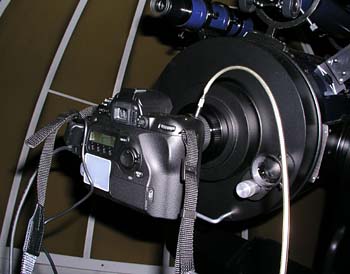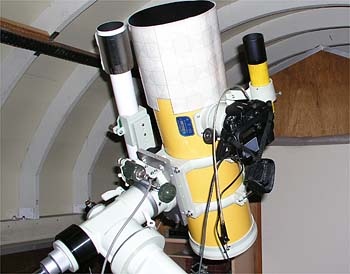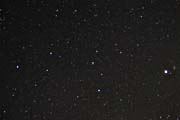 |
A star field image around the Leo with a wide-angled photo lens equivalent to f=35mm in film format.
Although no emphasizing process performed, I think you cannot distinguish this picture from that taken with photo films. Taken at Ooizumi vil., Yamanashi pref.
Feb 28 2003, 25:14 JST, 4min. exp.,
AF Zoom Nikkor 24-50mm, f=24mm, stop: F3.3,
Auto-guided with TAKAHASHI JP Equatorial
CCD sensitivity: ISO400, White Balance: Auto
No image retouching
Recording format: 12bit CCD-RAW, converted to 16bit TIFF(3024 x 2016) |
|
|
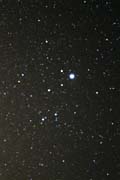 |
The constellation of Lyra taken with a diffusion filter. This camera shows me delicate stellar colors same as normal films.
Taken at Satomi vil., Ibaraki pref.
May 1 2003, 23:27, 23:33, 23:37 JST(+0900), 3shots composed with 5min. exp.,
AF Zoom Nikkor 24-85mm, f=50mm, stop: F3.6,
Auto-guided with Kenko SKYMEMO Equatorial
CCD sensitivity: ISO400, White Balance: Auto
No image retouching performed except image composing
Recording format: 12bit CCD-RAW, converted to 16bit TIFF(3024 x 2016) |
|
|
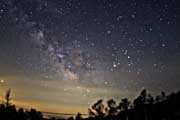
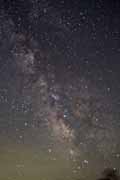 |
These two images show you the summer's Milky Way with a wide-angled photo lens. You can see complicated dark lanes in the Milky Way same with pictures taken by photo films.
Both images are taken at Koumi town, Nagano pref.
(upper) Apr 28 2003, 25:58 JST, 4min. exp.,
SIGMA 15mmF2.8 EX FISHEYE, stop: F3.4,
Auto-guided with Kenko SKYMEMO Equatorial
CCD sensitivity: ISO400, White Balance: Auto
Color balance and tone level adjusted with Photoshop5.5
Recording format: 12bit CCD-RAW, converted to 16bit TIFF(3024 x 2016)
(lower) Apr 28 2003, 27:24, 27:28, 27:34 JST, 3 shots composed with 4min. exp.,
AF Zoom Nikkor 24-50mm, f=24mm, stop: F3.3,
Auto-guided with TAKAHASHI EM-200 Equatorial
CCD sensitivity: ISO400, White Balance: Auto
Color balance and tone level adjusted with Photoshop5.5
Recording format: 12bit CCD-RAW, converted to 16bit TIFF(3024 x 2016) |
|
|
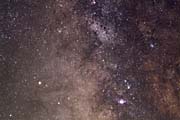 |
The Milky Way field around Sagittarius with a medium-ranged telephoto lens. Several nebulae and star clusters are distributed in this field.
Taken at Satomi vil., Ibaraki pref.
May 1 2003, 26:22, 26:28 JST(+0900), 2shots composed with 5min. exp.,
AF Zoom Nikkor 24-85mm, f=85mm, stop: F4.0,
Auto-guided with Kenko SKYMEMO Equatorial
CCD sensitivity: ISO800, White Balance: Auto
Color balance and tone level adjusted with Photoshop5.5
Recording format: 12bit CCD-RAW, converted to 16bit TIFF(3024 x 2016) |
|
|
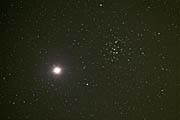 |
The open cluster of Praesepe and closing Jupiter. A tele-photo lens of f=180mm is equivalent to f=250mm in film format.
Taken at Ooizumi vil., Yamanashi pref.
Feb 28 2003, 25:45, 25:49 JST, 2 shots composed with 3min. exp.,
TAMRON SP f=180mm F2.5, stop: F3.5,
Auto-guided with TAKAHASHI JP Equatorial
CCD sensitivity: ISO400, White Balance: Daylight
No image retouching performed except image composing
Recording format: 12bit CCD-RAW, converted to 16bit TIFF(3024 x 2016) |
|
|
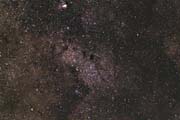 |
Around the Star-Clound in Sagittarius(M24). Taken at Kita-Ibaraki city, Ibaraki pref.
May 3 2003, 26:46, 26:52, 26:58 JST(+0900), 3shots composed with 5min. exp.,
TAMRON SP f=180mm F2.5, stop: F2.5,
Auto-guided with TAKAHASHI EM-200 Equatorial
CCD sensitivity: ISO800, White Balance: Auto
Color balance and tone level adjusted with Photoshop5.5
Recording format: 12bit CCD-RAW, converted to 16bit TIFF(3024 x 2016) |
|
|
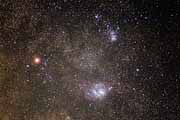 |
The Rendez-vous of Mars and M8, M20 in Sagittarius. You can detect a faint diffused nebula of IC1274 lying in east of M8.
Taken at Ooizumi vil., Yamanashi pref.
Unretouched image
Mars 8 2003, 27:56, 27:59, 28:03, 28:06 JST, 4 shots composed with 3min. exp.,
TAMRON SP f=300mm F2.8, stop: F2.8,
Auto-guided with TAKAHASHI JP Equatorial
CCD sensitivity: ISO400, White Balance: Daylight
Color balance and tone level adjusted with Photoshop5.5
Recording format: 12bit CCD-RAW, converted to 16bit TIFF(3024 x 2016) |
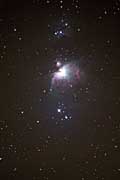 |
This is single-shot picture of the Great Orion Nebula with 2 minutes exposure. There was thin cloud.
Taken at Ooizumi vil., Yamanashi pref.
Unretouched image
Feb 28 2003, 22:31 JST, 2min. exp.,
TAKAHSHI 16cm(6.3") epsilon (f=530mm, F3.3),
Auto-guided with TAKAHASHI JP Equatorial
CCD sensitivity: ISO800, White Balance: Auto
Color balance and tone level adjusted with Photoshop5.5
Recording format: 12bit CCD-RAW, converted to 16bit TIFF(3024 x 2016) |
|
|
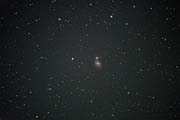 |
The Whirlpool Galaxy M51 in Canes Venatici. You can see an arm connecting two galaxies and dimmed outer region clearly.
Taken at Ooizumi vil., Yamanashi pref.
Unretouched image
Feb 28 2003, 27:30, 27:36, 27:41 JST, 3 shots composed with 5min. exp.,
TAKAHSHI 16cm(6.3") epsilon (f=530mm, F3.3),
Auto-guided with TAKAHASHI JP Equatorial
CCD sensitivity: ISO800, White Balance: Daylight
Color balance and tone level adjusted with Photoshop5.5
Recording format: 12bit CCD-RAW, converted to 16bit TIFF(3024 x 2016) |
|
|
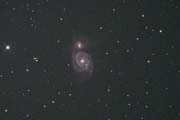 |
This image shows you a full-scaled central part of M51 above. You can detect the distribution of spot noise in image.
(Spot noises look like short line because this image have been composed plural shots)
|
|
|
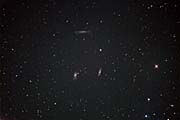 |
Three galaxies of M65, M66 and NGC3628 at the hind leg of Leo. This image shows you detailed structure of spirals and dark lane of NGC3628 clearly.
Taken at Ooizumi vil., Yamanashi pref.
Unretouched image
Feb 28 2003, 25:58, 26:03, 26:08 JST, 3 shots composed with 4min. exp.,
TAKAHSHI 16cm(6.3") epsilon (f=530mm, F3.3),
Auto-guided with TAKAHASHI JP Equatorial
CCD sensitivity: ISO800, White Balance: Daylight
Color balance and tone level adjusted with Photoshop5.5
Recording format: 12bit CCD-RAW, converted to 16bit TIFF(3024 x 2016) |
|
|
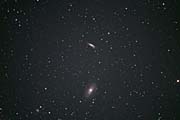 |
The Bode's galaxies M81 and M82 in Ursa Major. This image consists of single shot because I couldn't take plural images by clouds.
Taken at Ooizumi vil., Yamanashi pref.
Unretouched image
Feb 28 2003, 26:30 JST, 5min. exp.,
TAKAHSHI 16cm(6.3") epsilon (f=530mm, F3.3),
Auto-guided with TAKAHASHI JP Equatorial
CCD sensitivity: ISO800, White Balance: Daylight
Color balance and tone level adjusted with Photoshop5.5
Recording format: 12bit CCD-RAW, converted to 16bit TIFF(3024 x 2016) |
|
|
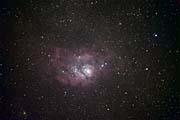 |
This is the Lagoon Nebula M8 in Sagittarius. This camera has low-sensitivity for reddish nebulae, but I can emphasize figures of those nebulae by hard retouching process.
I used a light-pollution suppressing filter to take this picture. Taken at Ooizumi vil., Yamanashi pref.
Unretouched image
Feb 28 2003, 28:34, 28:40, 28:46 3 shots composed with 5min. exp.,
TAKAHSHI 16cm(6.3") epsilon (f=530mm, F3.3),
Auto-guided with TAKAHASHI JP Equatorial
with IDAS LPS-P1 light-pollution suppression filter
CCD sensitivity: ISO800, White Balance: Daylight
Color balance and tone level adjusted with Photoshop5.5, LRGB color composed with StellaImage3.0 using R component as brightness signal
Recording format: 12bit CCD-RAW, converted to 16bit TIFF(3024 x 2016) |
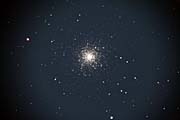 |
This image shows you a globular cluster of M13 in Hercules taken at f=1600mm prime focus. It was moonlit night but I can get good results for bright objects.
Taken at Ooizumi vil., Yamanashi pref.
Feb 14 2003, 27:09, 27:14, 27:19, 27:23 JST, 4 shots composed with 4.5min. exp.,
Meade 10" Schmidt Cassegrain with conversion lens (f=1600mm, F6.3)
Auto-guided with Meade LX200 Equatorial & Pictor 201XT
CCD sensitivity: ISO800, White Balance: Daylight
Color balance and tone level adjusted with Photoshop5.5
Recording format: 12bit CCD-RAW, converted to 8bit TIFF(3024 x 2016) |
|
|
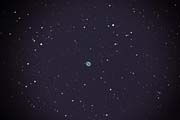 |
The Ring Nebula of M57 in Lyra. This camera takes images of planetary nebulae with considerably bluish color. Taken at Ooizumi vil., Yamanashi pref., under Moon light.
Feb 14 2003, 27:53, 27:58, 28:03, 28:07 JST, 4 shots composed with 4.5min. exp.,
Meade 10" Schmidt Cassegrain with conversion lens (f=1600mm, F6.3)
Auto-guided with Meade LX200 Equatorial & Pictor 201XT
CCD sensitivity: ISO800, White Balance: Daylight
Color balance and tone level adjusted with Photoshop5.5
Recording format: 12bit CCD-RAW, converted to 16bit TIFF(3024 x 2016) |
|
|
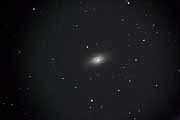 |
This image is Black-eye galaxy M64 in Come Berenices captured with the highest sensitivity of ISO 1600 and 7 minutes exposure time (Temperature: -3degC).
Very dimmed outer part can be recorded but spot noise can also be detected, any noise-reduction process should be needed.
Taken at Ooizumi vil., Yamanashi pref.
Unretouched image
Mar 7 2003, 25:39, 25:47, 25:55 JST, 3 shots composed with 7min. exp.,
Meade 10" Schmidt Cassegrain with conversion lens (f=1600mm, F6.3)
Auto-guided with Meade LX200 Equatorial & Pictor 201XT
CCD sensitivity: ISO1600, White Balance: Daylight
Color balance and tone level adjusted with Photoshop5.5
Recording format: 12bit CCD-RAW, converted to 16bit TIFF(3024 x 2016) |

